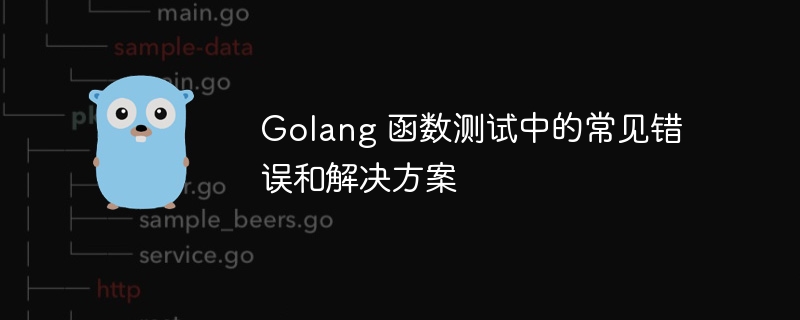go 语言函数测试的常见错误有:缺乏测试用例分组:使用 t.run() 分组以提高可读性。未检查测试失败原因:验证 got 与预期值和错误信息是否匹配。测试依赖性缺乏隔离:使用 mock 或测试 double 隔离依赖项。测试结果无法复用:使用测试表存储和重用测试数据。未覆盖所有代码路径:利用覆盖工具查找未覆盖的代码。通过遵循这些指南,可以提高测试质量和代码可靠性。

Go 语言函数测试中的常见错误及解决方案
在 Go 语言中编写函数测试时,可能会遇到一些常见的错误。本文将讨论这些错误并提供解决方案,通过实战案例帮助你避免或解决这些错误。
错误 1:没有使用 t.Run() 分组测试用例
立即学习“go语言免费学习笔记(深入)”;
- 问题: 测试用例之间缺乏组织,难以理解和维护。
-
解决方案:
func TestSampleFunction(t *testing.T) { tests := []struct { input []int output int }{ {[]int{1, 2, 3}, 6}, {[]int{-1, 0, 1}, 0}, } for _, tc := range tests { t.Run(tc.input, func(t *testing.T) { got := SampleFunction(tc.input) if got != tc.output { t.Errorf("Expected %d, got %d", tc.output, got) } }) } }
错误 2:未检查测试失败的原因
- 问题: 测试失败时,难以确定失败原因。
解决方案:
func TestSampleFunction(t *testing.T) { tests := []struct { input []int output int wantErr error }{ {[]int{1, 2, 3}, 6, nil}, {[]int{}, 0, errors.New("empty slice")}, } for _, tc := range tests { t.Run(tc.input, func(t *testing.T) { got, err := SampleFunction(tc.input) if err != nil && tc.wantErr != nil { if got != tc.output || !errors.Is(err, tc.wantErr) { t.Errorf("Expected %d, got %d; expected error %v, got %v", tc.output, got, tc.wantErr, err) } return } else if err != nil && tc.wantErr == nil { t.Errorf("Unexpected error: %v", err) } else if err == nil && tc.wantErr != nil { t.Errorf("Expected error %v, got nil", tc.wantErr) } }) } }
错误 3:测试依赖性之间缺乏隔离
- 问题: 测试因依赖项之间的交互而失败。
解决方案: 使用 mock 或测试 double 来隔离测试依赖项:
func TestSampleFunction(t *testing.T) { // 创建一个 mock 依赖项 mockDep := new(MockDep) t.Run("success", func(t *testing.T) { // 将 mock 依赖项传递给函数 got := SampleFunction(mockDep) // 验证 mock 依赖项的行为 if mockDep.CallCount != 1 { t.Errorf("Expected mockDep to be called once, got %d", mockDep.CallCount) } if mockDep.LastInput != input { t.Errorf("Expected mockDep to be called with input %v, got %v", input, mockDep.LastInput) } }) }
错误 4:测试结果无法复用
- 问题: 无法将测试结果用于其他测试或故障排除。
解决方案: 使用测试表来存储和重用测试数据:
var sampleTestTable = []struct { input []int output int }{ {[]int{1, 2, 3}, 6}, {[]int{-1, 0, 1}, 0}, } func TestSampleFunction(t *testing.T) { for _, tc := range sampleTestTable { t.Run(tc.input, func(t *testing.T) { got := SampleFunction(tc.input) if got != tc.output { t.Errorf("Expected %d, got %d", tc.output, got) } }) } }
错误 5:未覆盖所有代码路径
- 问题: 测试没有覆盖函数的所有代码路径。
解决方案: 使用覆盖工具(例如 coverage)来识别未覆盖的代码:
go test -coverprofile=coverage.out然后查看覆盖报告以查找未覆盖的代码路径。
遵循这些指南,你可以避免或解决 Go 语言函数测试中的常见错误,提高测试质量,为你的代码库提供更高的信心。



